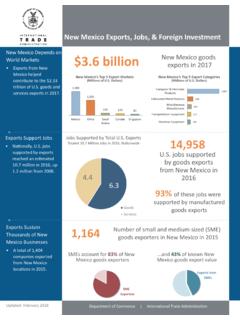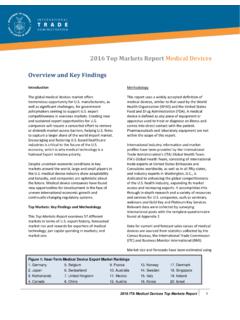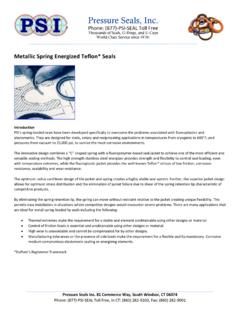Transcription of Global Steel Report - International Trade …
1 1 July 2016 Global Steel Report Department of Commerce | International Trade Administration 2 Global Steel Report Introduction and Trends At a challenging time for the Steel industry, the United States Government is committed to providing information to the public in an accessible and transparent manner. The Global Steel Report offers a straightforward interpretation of currently available statistical data concerning the Global Steel Trade and the regions and countries that play a large role in it. Information in this Report includes Global export and import trends, production, capacity, and consumption data. This information will provide current, objective, and relevant Global Steel Trade and industry data and will allow for new insights into the Global Steel marketplace.
2 Steel is a critical industry worldwide, and Steel products are a heavily traded commodity. In recent years, market changes, shifts in import and export levels, and weakness in the Global demand for Steel have negatively impacted Steel industries across the world . Along with shifting Trade patterns, world benchmark Steel prices have been trending downward since early 2011, and the financial outlook for many Steel companies has declined. The 2008-2009 Global financial crisis was particularly difficult for Steel industries, and this period will feature prominently in the following discussion of Global Steel indicators. 2015 was also a period of decline for the Steel industry, as weak Global demand caused declines in other indicators. 3 Global Steel Report Production For most of the last decade, Global crude Steel production has been growing.
3 Production totaled billion metric tons in 2005 and by 2015 had grown percent to billion metric tons an increase of 475 million metric tons over ten years. Global production dipped in 2009 following the Global financial crisis but rebounded quickly by 2010. In 2014, Global production hit a record high of billion metric tons. Weak Global demand for Steel in 2015 caused a slight contraction in crude Steel production worldwide, decreasing percent from 2014. The world Steel Association has forecasted relatively stagnant Steel demand levels for 2016 and 2017, which would indicate that production may hold steady at current levels in the near future. Crude Steel production growth rates reinforce the upward production trend of the past decade. Since 2006 there have been only three years with negative growth rates.
4 In 2008 and 2009, as the Global financial crisis impacted the Steel industry, growth rates bottomed out at percent and percent, respectively. Crude Steel production shrank in 2015, at percent, due to weak demand for Steel . In the majority of years in which Steel demand experienced positive growth, growth rates were above 5 percent. Growth peaked in 2010 when the rate hit percent. 2005200620072008200920102011201220132014 2015 World1,1481,2501,3481,3431,2391,4331,538 1,5601,6501,6701,62302004006008001,0001, 2001,4001,6001,800 Millions of Metric TonsGlobal Crude Steel ProductionSource: world Steel Production Annual Growth RatesSource: world Steel AssociationPercentage4 Global Steel Report Production by Region Among eight world regions, Asia and Oceania produced billion metric tons of Steel in 2015, accounting for 69 percent of the billion metric tons of Global production.
5 The European Union (28) was the second-largest Steel producing region in 2015 with a 10 percent share of production (166 million metric tons), followed by North America with a 7 percent share (111 million metric tons) and the Commonwealth of Independent States (CIS) with a 6 percent share (102 million metric tons). The distribution of shares by region held steady from 2014 but has changed markedly from a decade ago. Between 2005 and 2015, the majority of regions have seen their shares of production decrease, including the European Union, CIS, North America, South America, and Africa. The share of production held by Other Europe remained at 2 percent. Only the Middle East and Asia and Oceania had increases in their shares of Global production between 2005 and 2015.
6 The table below highlights the different performances across regions. Across all regions, Steel production fell in 2015. North America saw the largest negative growth rate, at percent, followed by Other Europe at percent. Prior to 2015, Steel production in Asia and Oceania and the Middle East had positive growth in every year since 2006, sometimes growing by double digits. All other regions experienced declines in Steel production, especially during the 2008-2009 financial crisis and again in 2012-2014. Asia and Oceania69%European Union (28)10%North America7%CIS6%South America3%Other Europe2%Middle East2%Africa1%Regional Share of 2015 Steel ProductionSource: world Steel Union (28) and Steel Production Annual Growth RatesSource : Worl d Ste e l As s oci a ti onNote : Se e Gl os s a ry for a l i s t of countri e s i n e a ch re gi on5 Global Steel Report Production by Country Four of the world s ten largest Steel producing countries are in Asia and Oceania: China, Japan, India, and South Korea.
7 China is the world s largest Steel producing country and accounted for nearly half of Global production in 2015 at percent a total of million metric tons. Japan ranked second at percent of Global production or million metric tons production, followed by India ( or million metric tons), the United States ( or million metric tons), and Russia ( or million metric tons). Top 10 Steel Producing Companies in 2015 Rank Company Production (mmt) 1 ArcelorMittal 2 Hesteel Group 3 Nippon Steel and Sumitomo Metal Corporation (NSSMC) 4 POSCO 42 5 Baosteel Group 6 Shagang Group 7 Ansteel Group 8 JFE Steel Corporation 9 Shougang Group 10 Tata Steel Group Source: world Steel Association KoreaGermanyBrazilTurkeyUkraineTop 10 Crude Steel Producing Countries in 2015 Source: world Steel AssociationProduction by Company ArcelorMittal, formed through the merger of Luxembourg-based Arcelor and India-based Mittal in 2006, has been the world s largest Steel -producing company for several years.
8 In 2015, ArcelorMittal produced million metric tons of Steel , or 6 percent, of Global production. China s Hesteel, formerly Hebei Iron and Steel , ranked second in 2015 with million metric tons of Steel production, followed by Japan s Nippon Steel and Sumitomo Metal Co., which merged in 2012, with million metric tons. Five of the top 10 companies are headquartered in China, and nine of the top 10 are headquartered in Asia and Oceania. ArcelorMittal is the only company headquartered outside Asia and Oceania region. 6 Global Steel Report Capacity Over the past decade, Global steelmaking capacity has grown in size every year. Between 2005 and 2015, million metric tons of capacity were added globally an increase of percent. Unlike production, which fell during the Global financial crisis in 2008-2009, steelmaking capacity continued to grow, though by nature, capacity is slower to respond to market conditions than production.
9 After an percent jump in 2013, Global capacity growth began to slow. Since 2013, capacity has increased by 4 percent or million metric tons. Capacity by Region Between 2005 and 2015, each region except the European Union had increases in its total amount of steelmaking capacity. Asia and Oceania saw the largest increase, adding million metric tons of capacity over the period, for a total capacity of billion metric tons in 2015. Notably, Asia and Oceania accounted for 89 percent of the million metric tons of Global steelmaking capacity added since 2005. The Middle East ranked second with an increase of million metric tons, followed by Other Europe which added million metric tons and CIS which added million metric tons. Capacity in the European Union decreased by million metric tons between 2005 and 2015.
10 In 2015, Asia and Oceania accounted for percent of Global steelmaking capacity, an increase of 15 percentage points from percent in 2005. The European Union ranked a distant second with 232 million metric tons of capacity, or percent of Global capacity. The chart below indicates annual growth rates of both Global steelmaking capacity and 2005200620072008200920102011201220132014 2015*World1,3761,4531,5781,6721,7701,893 1,9882,1022,2732,3212,36405001,0001,5002 ,0002,500 Millions of Metric TonsGlobal Crude Steelmaking CapacitySource:Organization for Economic Cooperation and Development (OECD), Half-Yearly Steel Statistical Report , January 2016 and June 2013*2015 capacity figure is an estimateEU (28)*OtherEuropeCISN orthAmericaSouthAmericaAfricaMiddleEastA sia ** , ,0001,2001,4001,6001,800 Millions of Metric TonsRegional Steelmaking CapacitySource:OECD*2005 figure for EU based on EU (27)**2015 capacity figures are estimates7 Global Steel Report regional steelmaking capacity.















